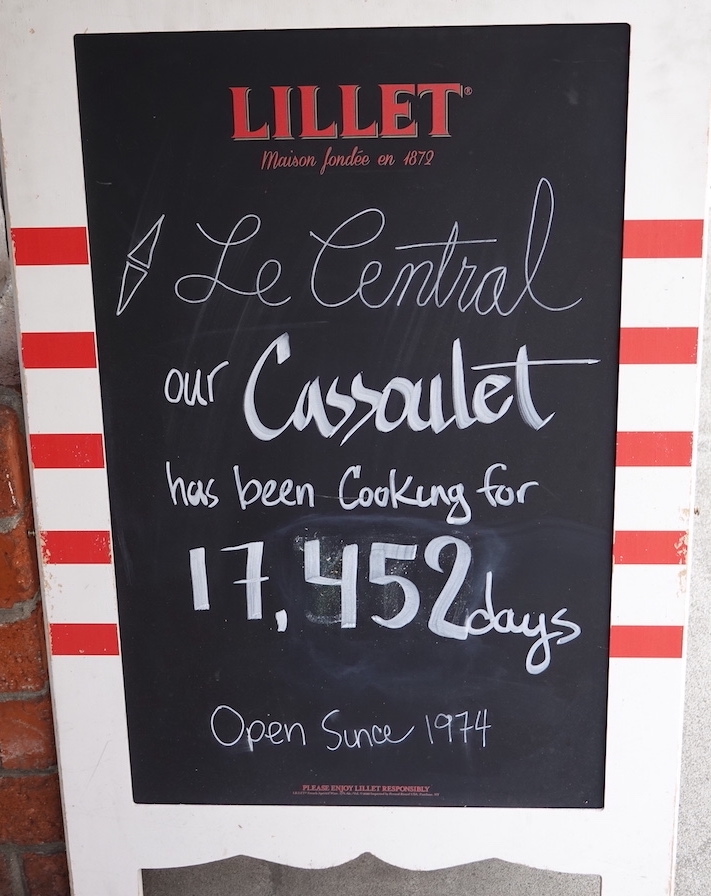
Outside this achingly authentic French Restaurant, Cafe Central advertises its signature dish. Cassoulet comes from Southwest France, and there is more than one version. Here it’s made with white beans, pork shoulder, lamb, duck confit, Toulouse sausage and French herbs. Photo by David DeVoss
New Orleans is not the only French city in America. From the cafes near the French Consulate to the celebration of Bastille Day; from the Museum of the Legion of Honor (a copy of the one in Paris) to the Matisse paintings donated by the Gertrude Stein family to the Museum of Modern Art, San Francisco has long been a city with a French accent. There’s a reason it was called the Paris of the Pacific.
In the early 1850s, French people were the most numerous immigrants in San Francisco. Why did they make the long trip from France to the West Coast? “French people were attracted to San Francisco by the Gold Rush and also to flee the grave political problems at home,” notes historian Claudine Chalmers, the author of French San Francisco. She’s currently working on a book about how French painter Jules Tavernier brought the landscape-focused Barbizon School of Painting to California. “He was the toast of San Francisco,” she notes. Some of his paintings, mostly from the 1870s and 1880s, are on display at the Palace of Fine Arts.
Going for the Gold
The Gold Rush, she explains, took place at about the same time as the Revolution of 1848. “Those who left France were aristocrats and professionals, merchants who lost everything,” says Chalmers, who is from Cannes, in the South of France. The trip was not easy – it involved a four to six-month voyage around Cape Horn.
One of the migrants was Isadore Boudin, a baker whose sourdough bread came to be called French Bread. Today, Boudin bread is still popular, and Boudin cafes are known for their signature lunch dish, a hollowed-out French bread bowl filled with a choice of soups. At the flagship store in Fisherman’s Wharf, you can peer through a 30-foot high window and see bakers at work. They still use the original mother dough, called the starter.
Etienne Guittard, who learned chocolate making in France, started his artisanal chocolate company in San Francisco in the mid-1800s, and five generations later, the family still runs it. In Gold Rush times, the miners eagerly bought Etienne Guittard’s chocolates, and now the company is known for supplying See’s Candies. In August 2022, Food and Wine Magazine named See’s the best snack in California. The Wall Street Journal declared Guittard chocolate chips the best for making brownies.
City of Paris
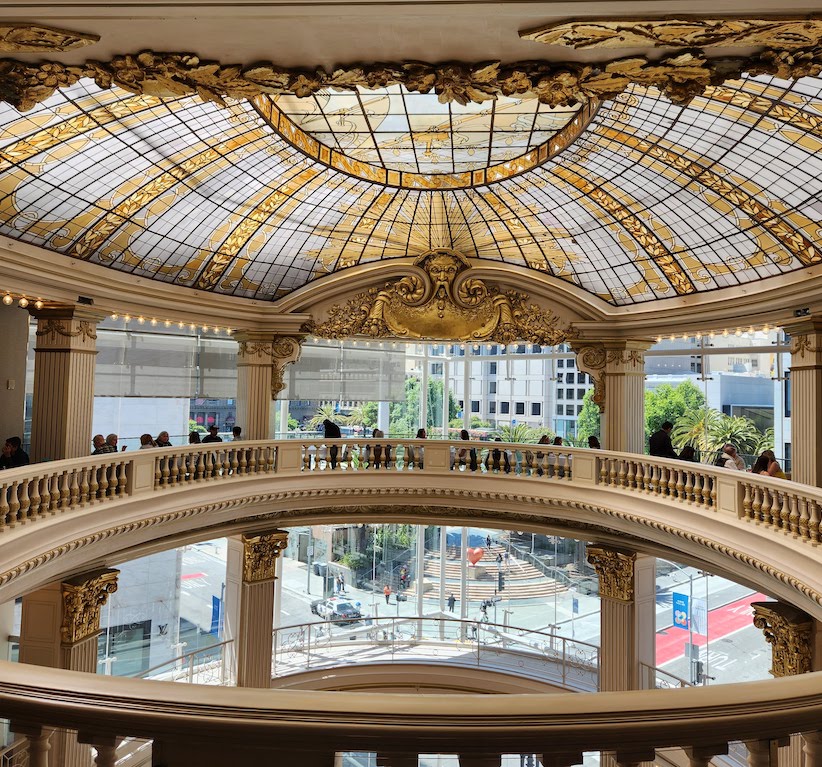
One of the most elegant places to have lunch or an early dinner, The Rotunda Restaurant, with its landmark stained-glass dome and skylight, is on the 4th level of the Neiman Marcus department store. Built as the City of Paris, the land was purchased in 1981 by Neiman Marcus. Despite a city order, the building was demolished, but the dome was saved. Today it is a calm and elegant place to have lunch and enjoy the view of Union Square. Photo by Jacqueline Swartz
Another early immigrant, Felix Verdier, opened a department store he called the City of Paris. Felix arrived in the SF Bay in 1850, on a ship stocked with silks, lace, wines and champagne. Miners and others came in rowboats to buy the goods, some with gold dust. Verdier went back to Paris to replenish his supplies and returned in 1850. Soon after, he opened a store, then moved to larger quarters.
Department stores were just becoming popular in France, and San Franciscans had never seen anything like The City of Paris. The lower level, called Normandy Lane, featured a wine cellar, cheese store and French book shop. A Neiman Marcus store since 1981, its opulent rotunda, with a stained-glass skylight over a gold and glass dome remains a fashionable place to take a break from shopping and have lunch or a drink with a view overlooking Union Square.
Many a City of Paris garment was laundered at one of the French laundries, started by immigrants from Bearn, in Southwest France. They had a monopoly, eclipsing Chinese-run laundries, because of their fine detail work. “There was a French town before there was Chinatown,” says Claudine Chalmers. There are families who still own the same home where their great-grandparents were born.” remarks Chalmers. “Some of these laundry owners were entrepreneurs who became so wealthy that they built little chateaux in the Napa Valley.”
At the same time, the ideals of “liberte, egalite, fraternite were expressed in the founding of the French Hospital. The benevolent aid society was responsible for the first mutual medical insurance in the US, notes San Francisco resident Georges Vieux. He came to the U.S. from France 15 years ago and is on the board of the Alliance Francaise and active in many of the several dozen French associations in San Francisco.
Legion of Honor Museum
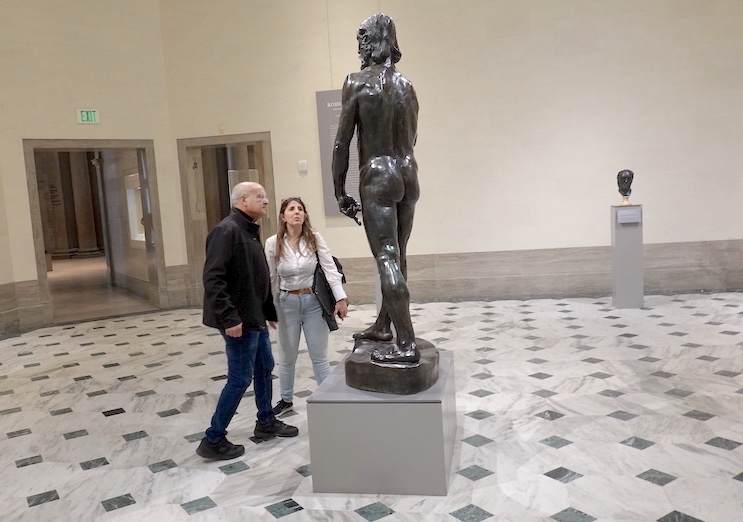
Museum visitors view one of many Rodin sculptures in this extraordinary collection. Rodin’s style changed and so did his career. In the 1860s and 1870s, he was criticized for being too naturalistic, grotesque, and sexual. Then, in the early 20th century, he was lauded as the artist who liberated sculpture from tradition. Photo by David DeVoss
One of the most distinctive French landmarks in the city is the Legion of Honor Museum. Located on cliffs overlooking the Pacific Ocean, it offers sweeping views of the Bay and one of the best collections of Rodin sculptures outside of France. It also has a permanent collection of paintings and textiles. A copy of the Légion d’ Honneur building in Paris, it was built thanks to Alma Spreckles, wife of the sugar magnate, Adolph Spreckles. Opened on Armistice Day, November 11, 1924, it is dedicated to the memory of the 3,000 Californians who perished in World War I.
Alma de Bretteville was an art-school dropout and an artist’s model 24 years Spreckles’ junior. She made no secret of her desire to marry a wealthy man and called Spreckles her “sugar daddy.” She put her wealth to good use. As a young bride, she went to Paris, where she met the sculptor Rodin and other artists, and bought paintings for her home and the museum.
Spreckles gained notoriety for his attempted 1884 murder of Mike de Young, editor-in-chief of the San Francisco Chronicle, who accused Spreckles of defrauding investors. Thanks to de Young’s shield– a package of books – the newsman survived the bullets. Spreckles was released after his lawyers pleaded temporary insanity. Years later, the rivalry continued, this time between the two museums, the de Young and the Legion of Honor.
On the other side of the city, opposite the gates of Chinatown, and up the hill from the Financial District, is an area of a few blocks that used to be known as Frenchman’s Hill. On one block is the Notre Dame des Victoires Catholic church and the French Consulate. Across the street is Café de la Presse and Le Central Bistro. Both couldn’t be more authentic. Café de la Presse used to feature French newspapers until the distributor went out of business. Across from the gates to Chinatown, it’s a favorite with French tourists.
Yet the last few years have not been easy. “We used to get the lunch crowd from the Financial District,” explains Olivier Daridon, manager of Café de la Presse. “Now a lot of people are staying home,” he says.
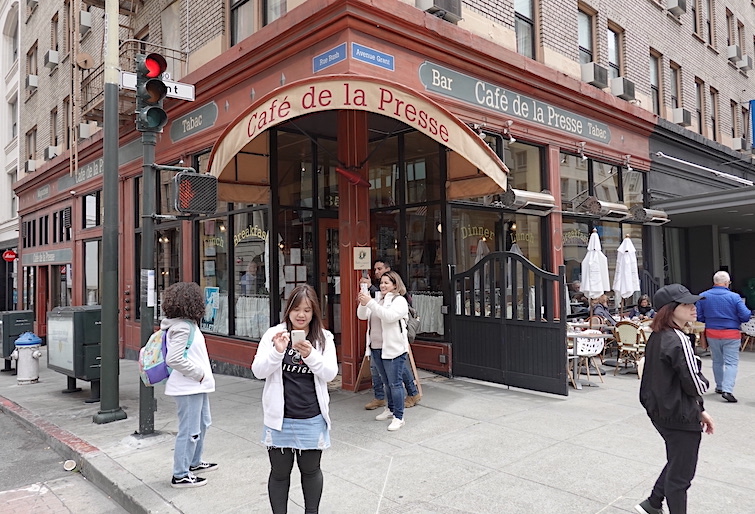
“A city hall, a cafe, a church – traditionally that’s what you need for a village,” remarked Cafe de la Presse founder and previous owner, Jean Gabriel. The City Hall is the French Consulate. The Cafe, with its outdoor section, is classic. The restaurant, now directed by Michelin-starred chef, Laurent Manique, offers top-notch French food and decor. Photo by David DeVoss)
Next door, Le Central has attracted some of the same customers for four decades. Regulars come for the classic dishes like Cassoulet – a sign outside says the dish has been cooking since 1974. Still, the waiters will tell you that stay-at-home tech employees have meant a decrease in customers.
These two places look the same as they did years ago. The same can’t be said for Belden Place, a two-block alley that used to be alive with French and Spanish restaurants, with so many tables outside that you could hardly tell which restaurant you were sitting at. These days, many of the restaurants have closed and it’s hard to find one open for lunch. The dinner trade is starting to return, however. Café Bastille, of the street’s mainstays, has merged with B44 Catalan Bistro and customers are returning,
On Bastille Day, “the whole street celebrates” says Café Bastille manager, Olivier Azancot. “Of course, business is not what it used to be,” he laments. “People are not back in their offices. Tourism is down. I believe the situation will get better,” he smiles. “It has to.”
Tarnished Golden Gate?
San Francisco faces a number of problems that include homelessness, drug overdoses and property crime. Most of the city’s 7,800 homeless are in the Tenderloin neighborhood next to downtown. While their numbers are less than the 42,000 homeless in Los Angeles, their continuing presence acts as a disincentive to professionals considering a return to the city.
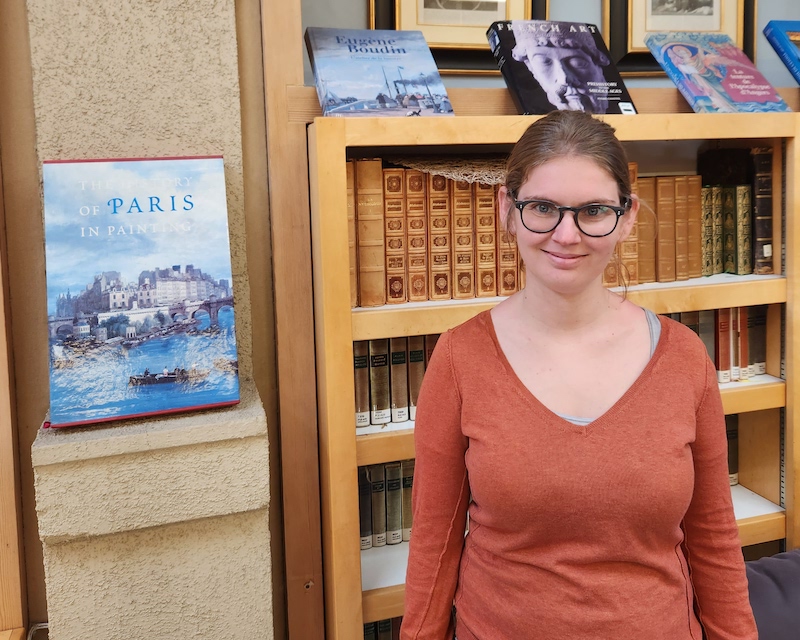
Noemi Herail, Executive Director of the Alliance Francaise. Located on Bush Street, the Alliance bookstore sells both new and used French books. Photo by Jacqueline Swartz
Valuing their heritage, French residents show no signs of leaving the city. The Bastille Day celebration at the Alliance Francaise will be smaller than the past, but next year’s event will be larger, predicts Alliance Executive Director Noemie Herail. The Alliance event space and theatre are being renovated, she says. “We have many events – the Fete de la Musique, a Christmas celebration, free films, coffee and conversation get-togethers.” The language classes the Alliance is known for continue, both in-person and online.
San Franciscans with French origins are gathering documents, journals and other mementos left by previous generations, she confides. Hopefully, these will be organized and displayed at some point.
“We have a long history, but we have to organize the French community to make our history and culture visible,” insists George Vieux.
New Restaurant Openings
While business is down in the Financial District, which housed some of San Francisco’s oldest French restaurants, other eateries are flourishing in trendy areas like Hayes Valley and the Mission District, where people live, not work.
Mijoté, on a trendy Mission District corner, is both traditional and contemporary. Run by Japanese-born chef, Kosuke Tada, who worked in Michelin-starred restaurants in Japan and France, the restaurant serves inventive haute cuisine at a reasonable price using local ingredients. Patrons who sit at the counter can see dishes being plated and can converse with staff. Halibut with haricot vert and turmeric is a surprise: it comes cold. Cured with vegetables in a kind of aspic, it is one of those unexpected “wow” dishes. The octopus with cauliflower is a popular choice. Wines by the glass are reasonably priced.
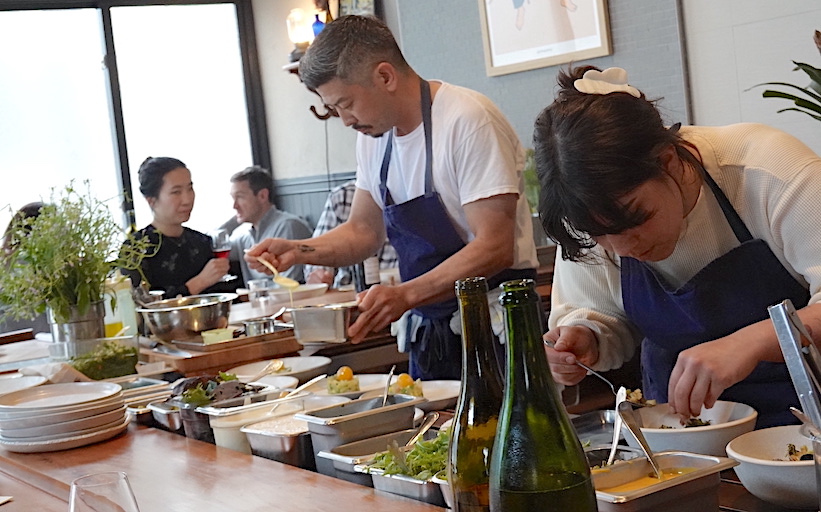
Mijote, located in a former sushi bar space, is a draw for San Francisco foodies. Diners sitting around the counter can observe how staff plate their meals and ask questions. Chef Kosaki Tuda’s focus on fresh, local ingredients reflects what is going on in France – lighter, more vegetable-focused fare. Photo by David DeVoss
B patisserie, a bakery café, was started by two pastry chefs who worked at top-notch bakeries and restaurants in San Francisco and Paris. Its tony, lower Pacific Heights location draws people from across the city. A must-try is the Kouign-amann, a squarish croissant with a layered buttery interior and a caramelized exterior.
San Francisco restaurants don’t have to go far to find fine wines. In the Napa Valley, about an hour and a half from the city, the first grape vines were planted in 1836 by San Francisco entrepreneurs. Moet et Chandon and Taittinger, have wineries in the region. There’s even a Champagne Trail, with tastings along the way. It’s a fine way to toast French San Francisco.![]()
Jacqueline Swartz’ past stories for the East-West News Service have examined California’s Napa Valley and the French town of Sète.

